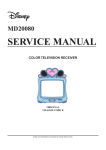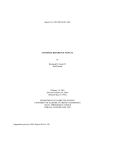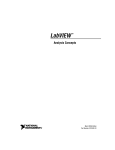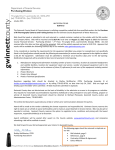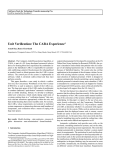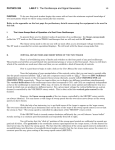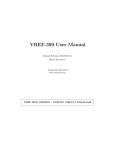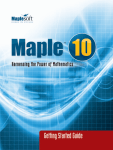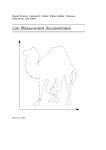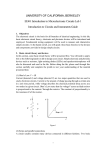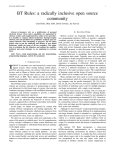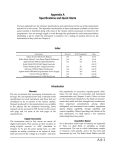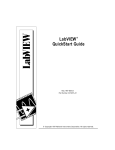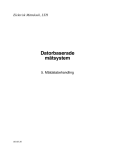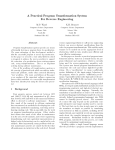Download Introduction - University of Toronto Scarborough
Transcript
The Instrumentation of Science PSC B01 H3S Course Notes and Laboratory Manual 2003 This manual can be accessed in electronic form via the PSCB01H3S Home Page at the following URL: http://www.utsc.utoronto.ca/~quick/PSCB01H3S/ I should like to thank UTSC technicians Ken Wesley and Bob Touchbourne for their competent and cheerful assistance in the development of this course. The generous donations of Myrianne Lorincz made the course possible. Stuart M. Quick 2003 287-7249 [email protected] This book was produced using Microsoft Office 98™ and LabVIEW 6i on a 192mB Macintosh G3 Computer Output was printed on the physics LaserWriter printers Text is in Palatino, Arial Narrow and Symbol fonts. Macintosh and LaserWriter are trademarks of Apple Computer Inc. Microsoft Office and LabVIEW are, respectively, trademarks of Microsoft Corporation and National Instruments. TABLE OF CONTENTS To the Student ........................................................................................................................... I-4 Course Information .................................................................................................................... I-5 Course Outline ........................................................................................................................... I-7 Lab/Test/Tutorial Schedule........................................................................................................... I-9 Introduction ............................................................................................................................ I-10 Notes Chapter 1 Elements of Physics......................................................................................... 1-1 Chapter 2 Aspects of Technology..................................................................................... 2-1 Chapter 3 Digital Basics ................................................................................................... 3-1 Chapter 4 Introduction to G.............................................................................................. 4-1 Chapter 5 Using G to Control an Instrument..................................................................... 5-1 Chapter 6 Sensing, Conditioning and Calibrating ............................................................. 6-1 Chapter 7 Using G on a Network....................................................................................... 7-1 Appendices Appendix A Specifications and Quick Starts .................................................................... AA-1 Appendix B Interfaces ...................................................................................................... AB-1 Appendix C A Guide for Using Oscar.................................................................................AC-1 Appendix D Term Project Ideas ........................................................................................ AD-1 Appendix E Varieties of Waveform Analysis......................................................................AE-1 Appendix F Aspects of Curvefitting...................................................................................AF-1 Labs Lab #1 Measuring By Hand........................................................................................ L1-1 Lab #2 Introduction to LabVIEW ................................................................................ L2-1 Lab #3 Using G to Control an Instrument................................................................... L3-1 Lab #4 The Data Acquisition (DAQ) Card ................................................................... L4-1 Lab #5 Using G on a Network..................................................................................... L5-1 To the Student The course notes in this manual are organized by general subject area, “Aspects of Technology”, “Using G to Control an Instrument” and so forth, and are intended to be more or less selfcontained. It was not intended they be read necessarily in the order in which they are presented as would be a set of lecture notes. Indeed, this manual contains no lecture notes as such. The lectures in this course will be given by the instructor as sketched in the Course Outline, and will dip from time to time into a number of chapters in parallel (a little like the way G executes a program!). The chapters should therefore be treated more for reference, to be consulted at the direction of the instructor. There are exceptions. Chapters 1 through 3 deal with material that is commonly covered in a first year course in physics (or at least over three semesters). These chapters are more “ordered” than the others, and should be read one after the other for best preparation. Chapter 4 is very much a prerequisite for Chapter 5. A selection of material from these chapters will form the content of the first four lectures of the course. This was a new course for UTSC as of January, 2002. Our intent was to make the course as interdisciplinary as possible, an objective that led to the decision to leave the laboratory unscheduled. We shall make every effort to find a three-hour slot every other week that will accommodate the varying schedules of our audience. If not, we shall try to make do with the laboratory given in the Monday tutorial period. Please bear with us. Stuart Quick January 2003 I-4 Course Information Course Information PSCB01 H3S (Calendar Description) A study of the computer control of various digital instruments used in the sciences, including programming with the G programming language, RS-232 and GPIB interfaces, meteorological and other sensors, and the analysis of the data by curvefitting and practical time series analyses. General The laboratory and tutorials in this course are highly structured and focussed as they are intended to supplement the course material. Though communal discussion is encouraged, students are expected to collect their own data at their own workstation and to do their own programming. Late materials are assigned a standard penalty of 10% per day. Prerequisite Texts of Immediate Use to the Beginner (PHYA10H3F or PHYA20H3F) & PHYA21H3S These texts, written by educators, were runners-up in our search for the suggested text for this course: Corequisite None 1. Instructor Dr. Stuart M. Quick Room S503B, Tel: 287-7249 email: [email protected] 2. Lectures W/F 9:00-10:00am Physics Lab S505 3. Tutorial/Lab M 9-12 am S505 Suggested Text R. H. Bishop, Learning With LabVIEW (Addison-Wesley, 1999) Manual Stuart M. Quick, PSCB01H3S Course Notes and Lab Manual 2003 (this book) Requirements and Marking Scheme The grade will be based on participation in laboratory /tutorial activities, assignments, two projects, a term test and a final exam. The marking scheme is as follows: Final Exam 30% Participation in Lab/Tutorial Activities 20% MidTerm Test 10% Level I Project 10% Level II Project 20% Assignments 10% J. Essick, Advanced LabVIEW Labs (Prentice Hall, 1999). This book was written by a physics teacher at Reed College, Oregon, who has been teaching a course using LabVIEW for several years. L. K. Wells and J. Travis, LabVIEW for Everyone (Prentice Hall, 1997). This book, though somewhat dated, is a recommended text for a course in LabVIEW programming in the Physics Dept. on the St. George campus. B. E. Paton, Sensors, Transducers & LabVIEW (Prentice Hall, 1999). This book was written by a member of the Physics Department of Dalhousie University. He has used LabVIEW for many years. Some of the LabVIEW demos in this book were written or inspired by Prof. Paton. Standard LabVIEW Documentation National Instruments provides the following manuals, which we list here in the order of most use to the beginner. Copies of these manuals are available for short term loan from the physics lab. They are also available on-line in pdf format. 1. 2. 3. User Manual This is the basic manual and starting point for anyone serious about learning G from the ground up. It has many excellent activities written by people whose objective is to teach. Functions and VI Reference Manual This manual lists (nearly) all the VIs. Use this when the LabVIEW Online Help is not available. G Programming Reference Manual This deals more with the underlying structure and intricacies of G. I-5 Course Information 4. 5. Data Acquisition Manual This is important in learning advanced aspects of DAQ. DAQ PCI-1200 User Manual. This slim volume is shipped with the PCI-1200 DAQ card. You will likely not need it in this course. Other LabVIEW Texts A number of texts on LabVIEW written by free-lance engineers and NI employees are useful for advanced topics and for solving specific thorny problems: • G. W. Johnson, LabVIEW Graphical Programming (McGraw-Hill, 2 nd Ed., 1997). I am especially impressed with Johnson’s contribution to the LabVIEW literature, especially as he is a Macintosh user and a Ham Radio enthusiast! • G. W. Johnson ed., LabVIEW Power Programming (McGraw-Hill, 1998). This book is more of a survey of the uses of LabVIEW and is of limited use to the student. • R. Jamal & H Pichlik, LabVIEW Applications and Solutions (Prentice Hall, 1998). This is one of a number of books in the “Virtual Instrumentation Series” describing a number of applications of LabVIEW. Of limited use to the student. • M. L. Chugani, A. R. Samant and M. Cerna, LabVIEW Signal Processing (Prentice Hall, 1998). As its title implies this book deals mostly with signal processing issues, which are mostly beyond the scope of these notes. • J. Travis, Internet Applications in LabVIEW (Prentice Hall, 2000). This book was invaluable in the writing of Chapter 10. About the Site Licence The Physical Sciences Division of UTSC has a site licence for LabVIEW 6i. We can therefore run LabVIEW on any platform (PC, Mac and Unix). It is our intention at the time of writing to make LabVIEW available for student use in this course on PCs and Macs in the physics lab area. Students may choose to purchase the Student Edition for use on their own personal computer at home. NI Website You can learn a good deal about LabVIEW, where and for what purposes it is used, from the National Instruments website: http://www.ni.com I-6 Instrument Manuals Radio Shack We have the Owner’s Manual which accompanies the Manual/Auto Range Dual-Display Digital Multimeter w/PC interface. You shouldn’t need this. Manuals from Tektronix, Agilent, Instek and Berkeley Nucleonics are shipped with the instruments and are available in the physics lab for short term loan: Tektronix TDS210 • User Manual. • Programmer Manual. This manual has all the SCPI commands and responses you need to know to program and control the oscilloscope. Agilent (Hewlett-Packard) HP34401A and HPE3640A • User and service manuals for the HP34401A digital multimeter and the HPE3640A programmable power supply. Instek Model GFG-8016G • User Manual for the Digital Function Generator Model GFG-8016G BNC • Users Manual for the Berkeley Nucleonics Model 625A/SG-100 Signal Generator Other Useful Materials The following inexpensive books produced and available from Radio Shack are useful for basic material on electronics and/or sensor circuits: • G. McWhorter & A. J. Evans, Basic Electronics, Cat 62-1394. • The Engineer’s MiniNotebooks by F. W. Mims III are good for quick ideas: 555 Timer IC Circuits, Op Amp IC Circuits, Optoelectronics Circuits, Basic Semiconductor Circuits, Environmental Projects, Magnet and Magnet Sensor Projects, Sensor Projects. Magazines The number of magazines on the newstands targetted for the electronics hobbyist is declining and those that remain tend to be British or German and expensive. Here are a two titles to look for: • • Electronics World, UK, $8.50 Elektor Electronics, UK, $9.95 Course Information Course Outline This is a sketch of the topics to be covered and the order of presentation that was anticipated at the time of writing. Some departures will inevitably occur in response to changes in priorities and the need to prepare students for upcoming labs or tutorials. Lect 1 Day W Date 7 Jan Topics Welcome and introduction to the course. The importance of instrumentation in the sciences. Types of instruments to be used here. The role of LabVIEW in the course. A quick look at Oscar. Why a project is a requirement of the course. Discussion of project ideas. Chapter Lab 2 F 9 Jan A survey of the basic physics underlying instrumentation Part I. Elements of DC circuits, Voltage/current sources, AC circuits, impedance, filters. (Preparation for Lab #1.) 1&2 1 3 W 14 Jan A survey of the basic physics underlying instrumentation Part II. Elements of DC circuits, Voltage/current sources, AC circuits, impedance, filters. (Preparation for Lab #1.) 1&2 1 4 F 16 Jan A survey of the analogue electronics underlying instrumentation: the need for signal conditioning or amplification, the bipolar junction transistor, the operational amplifier. 1&2 1 5 W 21 Jan Introduction to LabView and the G programming language Part I. What it is and why it is used. Laying down controls and indicators for the first time. Doing simple arithmetic. (Preparation for Lab #2). 4 2 6 F 23 Jan Introduction to LabView and the G programming language Part II. Doing simple arithmetic. Extracting numbers from strings. 4 2 7 W 28 Jan Introduction to LabView and the G programming language Part III. Loops, arrays and Graphs. 4 2 8 F 30 Jan A survey of common sensors used in the sciences: the thermistor, strain gauge, pressure/humidity/magnetic field sensors and others. Where they are used. How the voltage to be measured is produced and conditioned. 6 3&4 9 W 4 Feb A survey of gates and logic circuits: Simple logic. The use of LabVIEW tutorials in the learning of digital circuits. 3 10 F 6 Feb An overview of ways of cummunicating with, and controlling, instruments: RS-232, GPIB, the DAQ card. Advantages and disadvantages of each mode. The role of LabVIEW. App B & 6 3 One hour Test on material to this point in the Tutorial, 10-11:00 am Monday, 9 February. 11 W 11 Feb Communication and Control Using RS-232 Part I. The problems with serial communication. Using LabVIEW to import data from a serial device such as a digital multimeter and an oscilloscope. App B & 6 3 I-7 Course Information Using VISA drivers. (Preparation for Lab #3.) 12 F 13 Feb Communication and Control Using RS-232 Part II. App B & 6 3 February 16 - 20 Reading Week. No classes are held. 13 W 25 Feb Communication and Control Using GPIB. How GPIB is an advance on RS-232. The advantages of using VISA functions. Using LabVIEW to import data from a GPIB device such as an oscilloscope and a programmable power supply. App B & 6 3 14 F 27 Feb Introduction to the digital acquisition (DAQ) card. Advantages and disadvantages of using DAQ over a standalone instrument. (Preparation for Lab #4.) App A 4 15 W 3 Mar Communication and Control Using DAQ methods Part I. Using LabVIEW to measure a voltage on an analogue input line. App A 4 16 F 5 Mar Communication and Control Using DAQ methods Part II. Using LabVIEW to output a voltage on an analogue output line. App A 4 17 W 10 Mar Communication and Control Using DAQ methods Part III. Using LabVIEW to control using digital input/output lines. App A 4 18 F 12 Mar Overview of using G on a Network Part I. Survey of networking terminology. (Preparation for Lab #5.) 5 19 W 17 Mar Overview of using G on a Network Part II. Communicating with an FTP server (such as the UTSC weather station). 5 20 F 19 Mar Project Workshop 21 W 24 Mar Project Workshop 22 F 26 Mar Project Workshop 23 W 31 Mar Project Workshop 24 F 2 Apr Project Workshop EXAM on all material in the course in the April exam period. Exact date to be announced. The exam will take place in the physics laboratory. I-8 Course Information Lab//Tutorial/Test Schedule NOTE: At the time of writing the laboratory times had yet to be firmed up. If a three-hour bi-weekly block of time cannot be found, then the labs will be held over two tutorial times as outlined below. The labs will in any case be held in tutorial style. Lab/ Tutorial # 1 M 5 Jan No lab/Tutorial on this first day of term. 2 M 12 Jan Lab #1. Measuring By Hand 3 M 19 Jan Lab #1. Measuring By Hand (Continued) 4 M 26 Jan Lab #2. Introduction to LabVIEW 5 M 2 Feb Lab #2. Introduction to LabVIEW (Continued) 6 M 9 Feb Lab #3.Using G to Control an Instrument W 11 Feb 9:00 am Test #1 7 M 23 Feb Lab #3.Using G to Control an Instrument (Continued) 8 M 1 Mar Lab #4. The Data Acquisition (DAQ) Card 9 M 8 Mar 10 M 15 Mar Lab #5. Using G on a Network 11 M 22 Mar Lab #5. Using G on a Network (Continued) 12 M 29 Mar 13 F 2 Apr Lab #4. The Data Acquisition (DAQ) Card (Continued) Project Workshop Last day for submission of project report. I-9 Course Information Introduction A System, Stimulus and Response Most studies in the sciences could be said to be concerned with three general issues: a system, a stimulus and a response. A system might be an electric circuit, the stimulus a signal applied to it, and the response the output signal. A system might be a population of Arctic hares, the stimulus, a catastrophic drop in the food supply, the response the subsequent change in the population. A system might be the heart of a frog, the stimulus, an impulse from the brain, the response the resultant action of the heart muscle. A system might be the mantle of the earth, the stimulus a sudden earth slippage, the response the resulting pwave. And one could go on. stimulus response system A stimulus and a response can be thought of in a broad sense as being signals, that is to say, of being phenomena that can be described by a change in the amplitude or number of some quantity as a function of (usually) time, expressed in units of microseconds, days, years or centuries. The stimulus and response may be analog in nature—continuous functions of time—but the result of measuring the stimulus and response “curves” using an instrument like a multimeter or a counter at some clock time is a digital measurement. One obtains a sequence of numbers for measurements and the accompanying time stamps, together called an acquisition. The array is also known as a time series. A stimulus is often produced by a device called a transducer, and the response detected by a sensor. In this course we shall most often treat a sensor and a transducer as synonymous. How a response function differs from a stimulus function can yield vital clues about the makeup of the system. And this is what most sciences are all about. It is therefore important at the very outset of a study to possess the best possible measurements of both functions, and to know one’s instruments (including I-10 sensors or transducers) inside and out. These days scientists gather their data with multimeters, dataloggers, data acquisition cards, oscilloscopes, animal counters and the like. In the chapters to follow we shall have a lot to say about instruments, as instrumentation is a large part of the technology of modern science. What is Signal Analysis? In these notes we shall refer from time to time to the phrase signal analysis. Signal analysis is a general term applying to the study and interpretation of the stimulus and response functions for the purpose of extracting information about a system. Both “signals”, whether quantified in volts, number of animals or whatever require careful analysis with the best tools available. Signals can possess complex waveforms or have subtle easily-overlooked features that can turn out to be important in one’s interpretation about a system. The output from an electric circuit may be changed in amplitude as well as in phase. A signal may consist of several components whose amplitudes, frequencies and power levels need to be measured with sufficient accuracy to make possible the testing of an hypothesis. Signal analysis by this or any other name is concerned with these issues. Terminology of Convenience In this course we shall use an electrical terminology by default. We do this for convenience and consistency and not because what follows applies only to the discipline of physics or the subjects of electricity or electronics. As we have already implied by the examples we have chosen above, the phrases “signal”, “time series”, “function” etc should be understood to apply equally to a synapse trigger, a vibratory impulse, or an animal number just as well as to a voltage waveform—as long as the waveform is expressable as a function of time in the appropriate units. With this in mind we begin in Chapter 1 with some of the basic physics the student of science needs to know in order to use instruments correctly and most productively.










